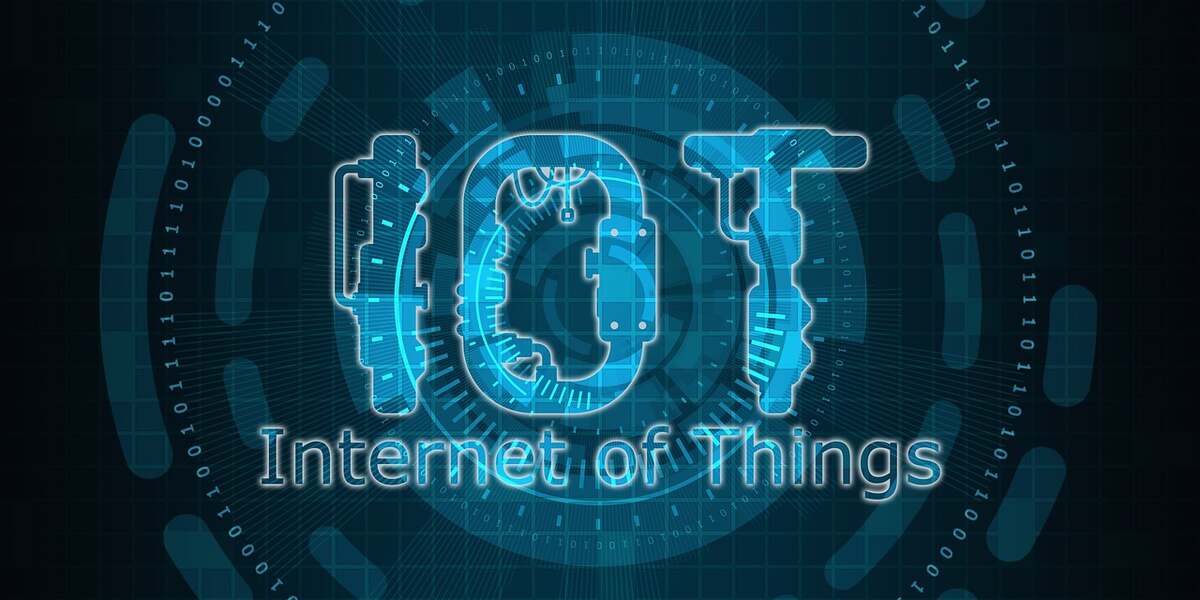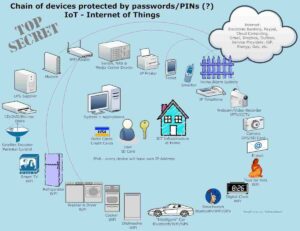In the modern era of technology, How we connect with the Internet of Things (IoT) is revolutionizing the world around us. IoT application development is at the heart of this transformation, enabling digital devices to communicate seamlessly with each other through data without requiring human intervention. This advancement enhances efficiency and paves the way for innovative solutions across various industries.
Understanding IoT Application Development
IoT application development involves creating systems where interconnected devices exchange data autonomously. These gadgets vary from commonplace home objects to complex industrial machinery equipped with sensors and software to collect, process, and share data over the Internet. The core idea is to build an ecosystem where devices can make intelligent decisions based on the data they receive, thereby reducing the need for human oversight.
Key Components of IoT Application Development
- Sensors and Actuators: These are the building blocks of any IoT system. Sensors collect information from the surroundings, including humidity, temperature, and motion, while actuators perform actions based on the data received, like adjusting a thermostat or activating an alarm.
- Connectivity: Reliable and efficient data transmission is crucial. IoT application development leverages various communication protocols such as Wi-Fi, Bluetooth, Zigbee, and cellular networks to ensure devices remain connected.
- Data Processing: Collected data must be processed and analyzed to extract valuable insights. This is where edge computing and cloud computing come into play, providing the necessary computational power to handle vast amounts of data.
- User Interface: While IoT systems aim for minimal human intervention, user interfaces (UIs) are essential for monitoring, control, and reporting. UIs can be web-based dashboards, mobile apps, or other interactive platforms.
Benefits of IoT Application Development
- Enhanced Efficiency: Automation of routine tasks leads to significant time and resource savings. For instance, in manufacturing, IoT systems can monitor equipment health and predict maintenance needs, reducing downtime and increasing productivity.
- Improved Decision-Making: IoT devices provide real-time data and analytics, enabling businesses to make informed decisions. This can lead to better resource management, optimized operations, and improved customer experiences.
- Cost Savings: IoT application development helps reduce operational costs by automating processes and improving efficiency. For example, smart energy management systems can significantly lower building energy consumption.
- Increased Safety and Security: IoT solutions can enhance safety and security through applications like smart surveillance systems, automated emergency responses, and advanced threat detection in cybersecurity.
Challenges in IoT Application Development
Despite its numerous benefits, IoT application development faces several challenges:
- Security Concerns: As more gadgets become internet-connected, the risk of cyberattacks increases. Ensuring robust security measures is paramount to protecting sensitive data and maintaining user trust.
- Interoperability: The diverse range of devices and communication protocols can lead to compatibility issues. Standardizing protocols and ensuring seamless integration between devices is a significant challenge.
- Data Management: Managing massive amounts of data effectively and ensuring data integrity and privacy are critical aspects of IoT application development.
The Future of IoT Application Development
The future of IoT application development looks promising, with developments in machine learning (ML) and artificial intelligence (AI) further enhancing the capabilities of IoT systems. AI and ML can enable predictive analytics, automate more complex tasks, and provide deeper insights from data, driving innovation across various sectors.
The Four Stages of IoT Application Development
IoT application development is a structured process involving multiple stages to ensure IoT systems’ seamless integration and functionality. Every phase is essential to the construction process of an effective IoT architecture, from the initial setup of networked devices to the final data processing and analysis. Here’s a detailed look at the four stages of creating an IoT architecture:
Stage 1 Networked Things
The first stage of IoT application development involves setting up the networked devices, typically wireless sensors and actuators. These devices are the foundational elements of any IoT system, designed to collect data from their environment and perform actions based on it. Key components of this stage include:
- Sensors: Devices that measure physical parameters such as temperature, humidity, light, motion, and pressure.
- Actuators: Components that execute actions like turning on a light, adjusting a thermostat, or activating a valve based on sensor data.
- Connectivity Modules: Wireless communication technologies such as Wi-Fi, Bluetooth, Zigbee, and cellular networks to ensure devices can transmit and receive data.
Stage 2 Data Aggregation and Conversion
The second stage focuses on aggregating sensor data and converting it from analog to digital. This stage is crucial for preparing the raw data for further processing and analysis. Key elements include:
- Data Aggregators: Devices or systems that collect data from multiple sensors, ensuring the data is organized and ready for processing.
- Analog-to-Digital Converters (ADCs): Hardware components that convert analog signals from sensors into digital data that computers and other digital systems can process.
Stage 3 Edge IT Systems
In the third stage, edge IT systems come into play to preprocess the data before it is sent to data centers or cloud platforms. Edge computing is essential for reducing latency, enhancing real-time processing capabilities, and minimizing the amount of data that needs to be transmitted. Key activities in this stage include:
- Data Filtering: Removing irrelevant or redundant data to ensure only valuable information is processed and transmitted.
- Data Compression: Reducing the size of the data to optimize transmission efficiency.
- Preliminary Data Analysis: Performing initial data analysis to generate quick insights and immediate responses to certain conditions, such as triggering an alert if a sensor detects an anomaly.
Stage 4 Data Center or Cloud Processing
The final stage involves sending the preprocessed data to centralized data centers or cloud platforms for more extensive processing, storage, and analysis. This stage leverages advanced computational power and storage capabilities to derive meaningful insights and drive decision-making. Key activities include:
- Data Storage: Storing large volumes of data securely for future reference and analysis.
- Advanced Analytics: Applying sophisticated algorithms and machine learning models to examine the information and find trends, trends, and actionable insights.
- Visualization and Reporting: Creating dashboards and reports to present the analyzed data in an easily understandable format for stakeholders and decision-makers.
An Example of an IoT Application Smart Home Security Systems
The Internet of Things (IoT) encompasses many applications that have become integral to our daily lives. The smart home security system is one of the most prevalent and practical examples of an IoT application. This system leverages interconnected devices to enhance the safety and security of our homes through automation and real-time monitoring.
Smart Home Security Systems
A smart home security system consists of various IoT-enabled devices that work together to protect your home. These devices include smart cameras, motion detectors, door and window sensors, and smart locks connected to a central hub or controller. Here’s how these components work together:
Smart Cameras
- Functionality: Smart cameras are equipped with motion detection and night vision capabilities. They stream live video via your tablet or smartphone, giving you remote home monitoring capabilities.
- Features: Many smart cameras offer two-way audio, enabling you to communicate with anyone near the camera. Additionally, they offer cloud storage for stored video, ensuring you can review past events.
Motion Detectors
- Functionality: Motion detectors use infrared sensors to detect movement within a specified area. The system can trigger alerts and activate cameras or sound alarms when detecting motion.
- Features: Advanced motion detectors can differentiate between humans and pets, reducing the likelihood of false alarms.
Door and Window Sensors
- Functionality: These sensors are installed to determine whether windows and doors are open or closed. They send notifications to your smartphone if an entry point is breached.
- Features: Some sensors also monitor environmental conditions like temperature and humidity, providing additional layers of protection.
Smart Locks
- Functionality: With smart locks, you can use a smartphone app to lock and open your doors remotely. They can be programmed to recognize authorized users and provide access via PIN codes, biometric scans, or smartphone proximity.
- Features: Smart locks can be integrated with other smart home devices, enabling scenarios like unlocking the door when a trusted person approaches or locking all doors at a specific time.
Integration and Automation
The true power of a smart home security system lies in its integration and automation capabilities. Every security equipment you own may be managed and observed from a single interface through a central hub or smart home platform (like Amazon Alexa, Google Home, or Apple HomeKit). Here are some examples of automation:
- Automated Alerts: Receive instant notifications on your smartphone when any sensor is triggered or cameras detect unusual activity.
- Scheduled Actions: Program your system to arm or disarm at specific times, ensuring your home is always protected when you’re away.
- Scenario-Based Automation: Create scenarios like “Away Mode,” where the system locks all doors, turns off lights, and activates cameras when you leave the house.
Benefits of Smart Home Security Systems
- Enhanced Security: Real-time monitoring and instant alerts ensure you’re always aware of what’s happening in and around your home.
- Convenience: Remote control and automation reduce the manual intervention requirement, which facilitates your home security management.
- Peace of Mind: Knowing your home is protected by a sophisticated, interconnected system provides greater security and peace of mind.
Conclusion
IoT application development is shaping the future of connectivity, making our lives more efficient, safer, and smarter. As technology develops further, the possibility for IoT systems to revolutionize industries and improve daily life is immense, highlighting the importance of continued investment and innovation in this field.
Understanding the four stages of IoT application development is essential for creating a strong and effective IoT architecture. Each stage, from setting up networked devices to processing data in the cloud, is vital in ensuring seamless operation and success of IoT systems. Integrating these stages will become even more sophisticated as IoT technology evolves, driving further innovation and transforming various industries.









